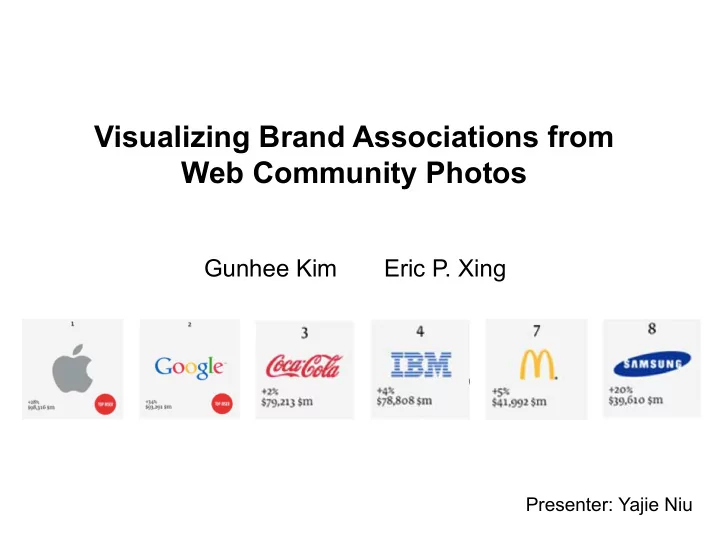

Visualizing Brand Associations from Web Community Photos Gunhee Kim Eric P. Xing Presenter: Yajie Niu
Brand Equity & Brand Associations (What Comes to Mind When You Think of …) • Brand Equity • A set of values or assets linked to a brand's name and symbol • Brand Association • Consumer-driven brand equity • A set of associations that consumers perceive with the brand • Top-of-mind attitudes or feelings toward the brand basketball, golf, … swimming, diving, beach, … Slide credits: Kim & Xing
Photo-based Brand Associations How can we find out people’s brand associations? • Traditional: textual data from consumer responses to questionnaires • Our idea: Take advantage of large-scale online photo collections • No previous attempts so far to leverage the pictures Traditional way: Our way: In-N-Out [Dane et al. 2010] 3
Main Contributions 1. Visualize brand associations in both image and subimage level 2. Develop an algorithm to jointly 1. Detect and cluster key pictorial concepts 2. Localize the regions of brand in the images 3. Demonstrate and evaluate this approach on image dataset: 1. From five websites ~5 million images of 48 brands of 4 categories 2. 4
Approach – KNN Graph Generation Feature extraction • Dense feature extraction of Color SIFT and HOG Image Similarity Measure • Histogram intersection Constructing K-Nearest Neighbor graph • Repeat random divide-and-conquer process for several times Slide credits: Kim & Xing 5
Approach – Exemplar Detection/Clustering Detecting L number of exemplars • A small set of representative images • Diversity ranking algorithm (temperature maximization) [Kim & Xing 2011] • Solving submodular optimization to obtain exemplars Clustering • Each image is associated with its closest exemplar • Random walk model Slide credits: Kim & Xing 6
Approach – Brand Localization via Cosegmentation Find the regions that are most relevant to the brand • Separately applying the cosegmentation algorithm to each cluster • Use MFC algorithm [Kim&Xing. 2012] to each cluster of coherent images • Foreground modeling • Region segmentation Then, go back to graph generation – a closing loop Slide credits: Kim & Xing 7
Visualization – Brand Association Maps Goal: Compute two coordinates of key clusters ( r , θ ) • Radial distance: a larger cluster closer to the center (Based on • Angular distance: the smaller, the higher correlation Nielson’s BAM) Radial distance • Compute stationary distribution of nodes Angular distance • Pairwise similarity btw clusters S using the Angular distance random walk with restart [Sun et al. 2005] • Using spherical Laplacian eigenmap [Carter et al. 2009.] Radial distances Slide credits: Kim & Xing 8
Experiments – Brand Association Maps Weddings Events sponsored Brands' characteristic by brands visual themes Slide credits: Kim & Xing 9
Experiments – Exemplar Detection/Clustering Groundtruth for clustering accuracy • Randomly select 2000 sets of three images • Manually label which two images are more similar, in each set • Compute the similarity using our approach • Accuracy is measured by how many sets are correctly clustered Sub-M: Multiple runs of our clustering + cosegmentation Sub: Our clustering without cosegmentation Kmean/Spect: K-mean clustering / Spectral clustering LP: Label propagation [Raghavan et al. 2007] AP: Affinity propagation [Frey & Dueck 2008] Observations Cosegmentation for brand localization improves the clustering performance Slide credits: Kim & Xing 10
Experiments – Brand Localization Task: Foreground detection • Manually annotate 50 images per class • Accuracy is measured by intersection-over-union Acc = GT i ∩ R i GT i ∪ R i Slide credits: Kim & Xing 11
Experiments – Correlation with Sales Data Photo volumes vs. Market share • Nike’s market share is 57.6% in sports brands. How’s about image volumes? • Based on brands’ annual reports Observations • Ranking are roughly similar, but the proportions do not agree. Slide credits: Kim & Xing 12
Discussions • Strength/Benefits • Get images from social media – cheap, instantaneously • Large amount of images • Reach a large crowd of potential customers • Introduce a novel source of data for the analysis. • Exploring the images conveys complementary views on the brand associations over the texts. • However, need to handle redundant/noisy clusterings, and polysemous brand names 13
Conclusion Study of brand associations from millions of Web images Jointly achieving two levels of visualization tasks • Visualizing core pictorial concepts associated with brands • Localizing the regions of brand in images Various potential applications • Online multimedia contextual advertisement, competitor mining Slide credits: Kim & Xing 14
Recommend
More recommend